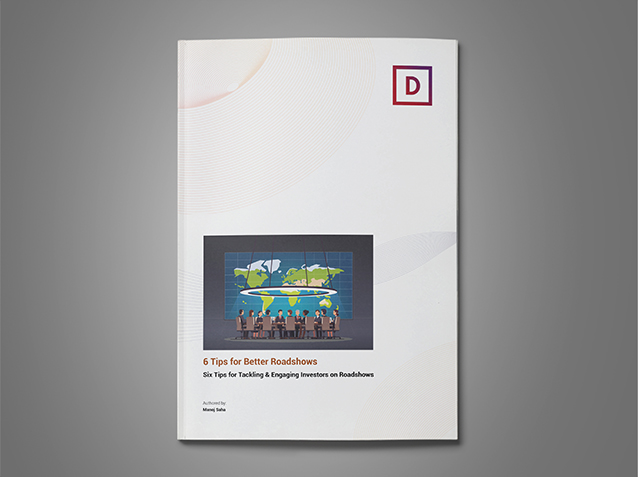6 Tips for Better Roadshows
Six Tips for Tackling & Engaging Investors on Roadshows
Meetings are an important way for people to come together for a common purpose. Planning for such meeting prevents poor performance and improves the chances of a desired outcome. Strategic planning allows you to project your company optimally, and also frame the narrative towards a specific goal. Here are six important tips for successfully tackling and engaging with investors on roadshows:
-
Build a Strong Investment Thesis.
“Story, as it turns out, was crucial to our evolution — more so than opposable thumbs. Opposable thumbs let us hang on; story told us what to hang on to.” – Lisa Cron. Investors too love a good story. To make it gripping, think of having a start, middle, and an “aha” end. Do your research on compelling and familiar reference points and comparisons to substantiate the reasons for considering your company as a potential investment. Use language that investors can easily understand and keep your key take-home messages consistent across all your communication collaterals, including your annual report and your corporate website.
-
Target your investors intelligently.
With budget constraints and management accessibility becoming increasingly scarce, it is essential that you should focus on the most appropriate types of investors that best fit the bill, both in terms of their investment style, and in terms of being favourable to the company’s shareholder register. By reserving most of your time for investor interactions, you may find it useful to outsource the investor targeting exercise, allowing you to be free from a task that can be highly research intensive; time consuming and desk-bound. The strong ROI of buyingsuch research is well proven.
-
Know your investor well and be prepared.
Research the investor’s investment philosophy and be thoroughly prepared before the meeting on the possible questions you could be asked. It often helps to prepare a detailed FAQ with possible answers and data points to ensure all members of the management team speak the same language. Try to know your investor well and investigate the fund’s typical investment mandate and their typical holding pattern. This can help you to gauge whether they are short-term or intrinsic investors, and assess whether they enhance your profiling priorities.
-
Make your engagement a two way street, without being aggressive.
You can’t always expect every meeting to end with a clear indication of the investor’s interest in the company (whether to invest or not). Instead, focus on framing an interactive session to heighten investors’ interest. Ask direct questions and assess their familiarity with the sector. Try to educate them about the drivers of your business and factually correct any flawed assumptions they might have. Make sure that you start with an appealing introduction of the company and follow through with an engaging storyline to demonstrate future growth. End the meeting with agreed ‘next steps’, without being pushy. It is usually best to leave feedback type questions to your IR agency to get an honest and un-filtered view.
-
‘Float like a butterfly, sting like a bee.’ Mohammed Ali.
A roadshow is often exposed to last-minute changes in locations and timings. Nowadays, investors get multiple meeting offers coming across their tables and they may not like to lock down meetings too far in advance. You can also consider adding an additional day for certain cities to fix impromptu meetings. While planning the roadshow schedule, be disciplined with. ‘hard stops’ and accurately estimate the travel times between meetings. Be able to accommodate last-minute changes by offering discussions over breakfast, lunch or dinner.
-
Implement a punctual feedback mechanism.
Roadshows are part of a continuous investor engagement process. Incorporating a mindful follow-up mechanism can help you collect quality feedback on the meeting. Since an investor rarely decides immediately after their first meeting, assess whether they are open to receiving your newsletters and periodic results as part of your investor cultivation process (viz. content marketing). Make them part of your recurrent feedback surveys and understand their evolving sentiment. Such an engagement will tell investors how important they are to you, and underlines the transparent culture of your company.

6 Tips for Better Roadshows
To download and save this article.
Authored by:
Manoj Saha
manoj.saha@dickensonworld.com
To know more on how Dickenson can assist you at this critical juncture, email to enquiry@dickensonworld.com


Leave A Comment